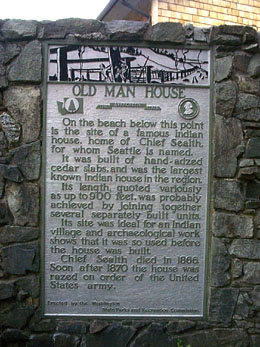On August 12, 2004, the Washington State Parks and Recreation Commission gives Old Man House State Park, located on the eastern edge of the Kitsap Peninsula, to the Suquamish tribe. The one-acre park, which includes a shell-strewn beach, is sacred to the tribe. It was the site of their "mother village" and of Chief Seattle's longhouse. This is the first time the state has ever given land to a tribe.
In 1904, when the tribe was poor and struggling, it sold the land to the U.S. Army. Later developers owned it. It became a state park in 1950.
What to do with the park was controversial in the town of Suquamish in Kitsap County. One neighborhood group opposed the transfer and another joined with the tribe in the effort to make it happen. Reverend Tom Thresher of the Suquamish Community Congregational United Church of Christ testified that "You have an opportunity to heal old wounds, and I think reach out a hand in friendship today that I think will heal our community" (The Seattle Times).
The decision of the seven-member commission was unanimous. After it was made, Buzz Whitely, who opposed the transfer, said that he felt it was made in response to an emotional appeal and in disregard of the law. He feared that the land would be made private or used for development or that the tribe would allow drinking and fireworks on the beach.
Tribal member Rob Purser, who led the tribe's effort to obtain the park, stated, "This is a good step in the healing process for the tribe, to see this type of turnaround taken by the state government" (The Seattle Times).
There are restrictions and conditions involved in the transfer. The Suquamish promised to spend $50,000 over the next five years to maintain the park. The state can take the park back if the tribe tries to privatize the land or fails to adhere to other conditions involving park hours and so on.
Budget cutbacks had limited the state's own maintenance of the park. The signs were updated in 1975, and stated that the park had been used by the Suquamish "who once lived in the area" (The Seattle Times).
The Suquamish have been doing well. They opened a casino in the summer of 2003, which is located just west of the Agate Pass Bridge. They have been buying property on their Kitsap Peninsula reservation.
When the decision was announced, the commission had to recess to allow tribal members to celebrate. They sang a traditional song of thanks and beat on drums. About 20 Suquamish who had arrived by canoe banged their paddles on the floor.
Park Commission chair Joe Taller explained that the decision was made on the basis of who could best preserve the park and tell the story of Old Man House and the land's significance.

